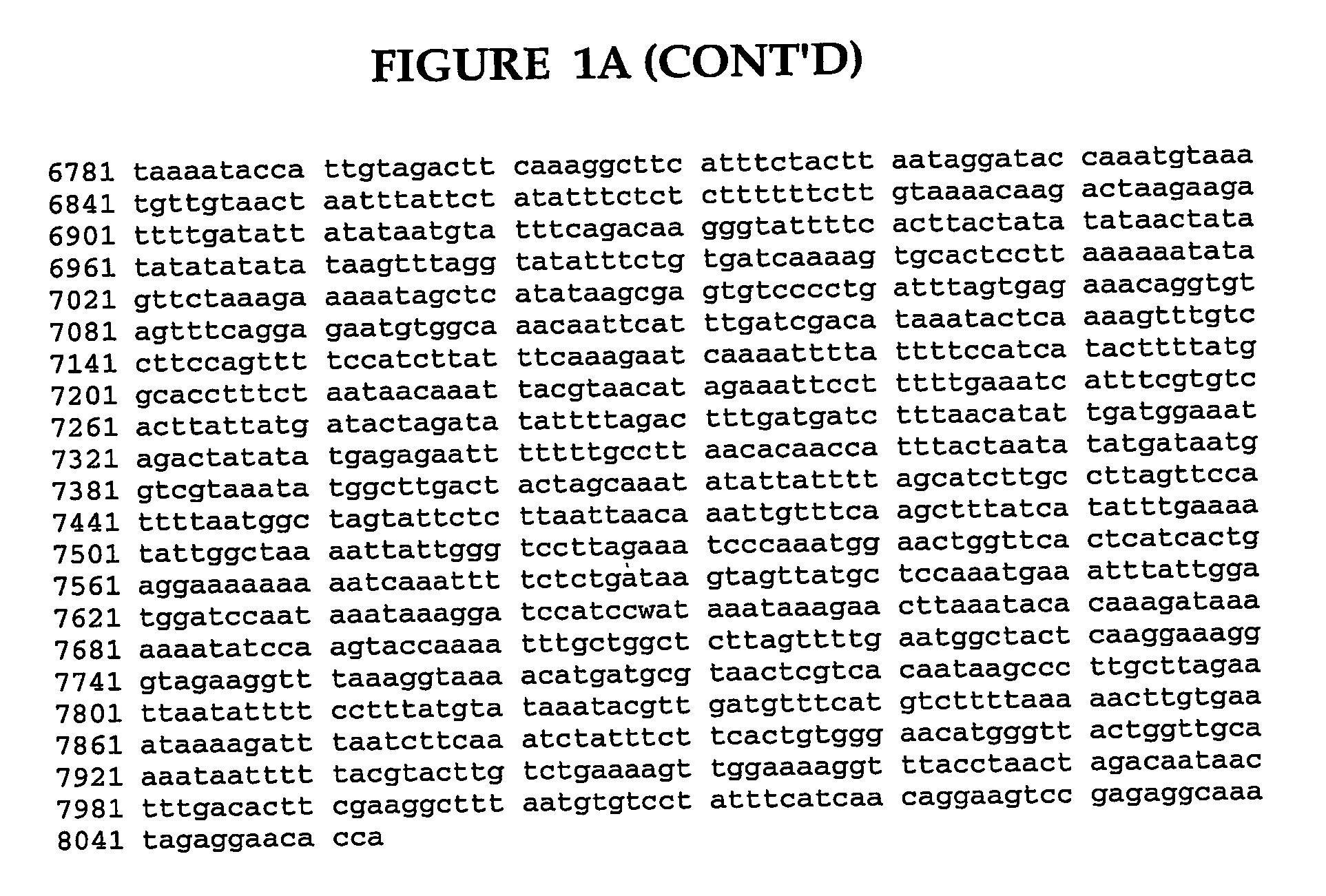Porcine fgl2
a technology of fgl2 and porcine fgl2, which is applied in the field of new drugs, can solve the problems of indefinite survival of pig-to-primate solid organ xenografts and the shortage of available organs, and achieve the effect of preventing the prothrombinase activity of porcine fgl2
- Summary
- Abstract
- Description
- Claims
- Application Information
AI Technical Summary
Benefits of technology
Problems solved by technology
Method used
Image
Examples
example 1
Cloning of the Porcine fgl2 Gene (pfgl2)
[0164] A bacteriophage λ EMBL3 SP6 / T7 adult porcine genomic library was obtained from Clontech Laboratories (Palo Alto, Calif., USA). A 659 bp PCR product was amplified from exon 2 of the mouse fgl2 (mfgl2) cDNA and labelled with α-32P-dCTP for use as a probe. Approximately 1.2×106 viral clones were screened by hybridization with the radiolabeled mfgl2 probe. Three positive clones were identified, with porcine genomic DNA inserts ranging in length between 13 and 17 kb. After plaque purification, the three clones were individually plated at high density and their DNA was extracted from the bacterial lysate.
[0165] A restriction map of each clone was prepared by digestion with XhoI, SalI, SstI, HindIII, and KpnI, alone and in combination (FIG. 4). Restriction fragments from each clone that contained exons 1 and / or 2 were identified by Southern blotting using the murine exon 2 probe and a 161 bp murine exon 1 probe (FIG. 7). The pfgl2 gene was ...
example 2
Determination of the Chromosomal Location of the Porcine fgl2 Gene Using Fluorescence In-Situ Hybridization (FISH).
Methods
Porcine Lymphocytes
[0174] Lymphocytes were isolated from porcine blood using standard techniques, and cultured in a-minimal essential medium (α-NMEM) supplemented with 15% fetal calf serum, 1% L-glutamine, and phytohemagglutinin (PHA) at 37° C. for 72 hours. Cells were harvested and slides were prepared using standard procedures including hypotonic treatment, fixation, and air dry.
Fluorescence In Situ Hybridization (FISH) Assay
[0175] The 12.8 kb porcine genomic DNA SalI restriction fragment of genomic library Clone 1 (containing almost all of the pfgl2 gene) was used as a probe for FISH. The DNA was biotinylated with dATP using the Gibco BRL BioNick labelling kit (15° C., 1 hr). The procedure for FISH detection was performed as previously described (51,52). Briefly, slides were baked at 55° C. for 1 hour. After RNase A treatment, the slides were denature...
example 3
Generation of Anti-pfgl2 Antibodies
[0178] A peptide consisting of the C-terminal 19 amino acids of pfgl2 was synthesized, conjugated to KLH, and used for immunization (by standard protocol) of two New Zealand white rabbits (rabbits GN9179 and GN9180). Post-immunization serum samples collected from both animals were found to react by ELISA against the 19aa peptide used for immunization, while pre-immune serum samples showed no reactivity. IgG was subsequently isolated from the sera by Protein G Sepharose affinity chromatography. On Western blot, the purified IgG from both animals recognized recombinant pfgl2 protein generated by pfgl2bv infection of insect cells (FIG. 18). These results suggest that these polyclonal rabbit anti-pfgl2 antibodies can be utilized for analysis of pfgl2 protein expression in porcine cells and tissues by Western blot.
PUM
| Property | Measurement | Unit |
|---|---|---|
| temperature | aaaaa | aaaaa |
| temperature | aaaaa | aaaaa |
| nucleic acid seqeuence | aaaaa | aaaaa |
Abstract
Description
Claims
Application Information
 Login to View More
Login to View More - R&D
- Intellectual Property
- Life Sciences
- Materials
- Tech Scout
- Unparalleled Data Quality
- Higher Quality Content
- 60% Fewer Hallucinations
Browse by: Latest US Patents, China's latest patents, Technical Efficacy Thesaurus, Application Domain, Technology Topic, Popular Technical Reports.
© 2025 PatSnap. All rights reserved.Legal|Privacy policy|Modern Slavery Act Transparency Statement|Sitemap|About US| Contact US: help@patsnap.com



